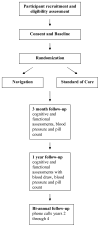Preventing recurrence of thromboembolic events through coordinated treatment in the District of Columbia
- PMID: 21951411
- PMCID: PMC3474334
- DOI: 10.1111/j.1747-4949.2011.00654.x
Preventing recurrence of thromboembolic events through coordinated treatment in the District of Columbia
Abstract
Rationale: PROTECT DC examines whether stroke navigators can improve cardiovascular risk factors in urban underserved individuals newly hospitalized for stroke or ischemic attack. Within one-year of hospital discharge, up to one-third of patients no longer adhere to secondary prevention behaviors. Adherence rates are lower in minority-underserved groups, contributing to health disparities. In-hospital programs increase use of stroke prevention therapies but may not be as successful in underserved individuals. In these groups, low literacy, limited healthcare access, and sparse community resources may reduce adherence. Lay community health workers (navigators) improve adherence in other illnesses through education and assisting in overcoming barriers to achieving desired health behaviors and obtaining needed healthcare services.
Aims and design: PROTECT DC is a Phase II, single-blind, randomized, controlled trial comparing in-hospital education plus stroke navigators to usual care. Atherogenic ischemic stroke and transient ischemic attack survivors are recruited from Washington, DC hospitals. Navigators meet with participants during the index hospitalization, perform home visits, and meet by phone. They focus on stroke education, medication compliance, and overcoming practical barriers to adherence. The interventions are driven by the theories of reasoned action and planned behavior.
Study outcomes: The primary dependent measure is a summary score of four objective measures of stroke risk factor control: systolic blood pressure, low-density lipoprotein, hemoglobin Hb A1C, and antiplatelet agent pill counts. Secondary outcomes include stroke knowledge, exercise, dietary modification, and smoking cessation.
Conclusion: PROTECT DC will determine whether a Phase III trial of stroke navigation for urban underserved individuals to improve adherence to secondary stroke prevention behaviors is warranted.
© 2011 The Authors. International Journal of Stroke © 2011 World Stroke Organization.
Conflict of interest statement
Conflict of interest: None declared
References
-
- Rosamond W, Flegal K, Furie K, et al. Heart disease and stroke statistics--2008 update: a report from the American Heart Association Statistics Committee and Stroke Statistics Subcommittee. Circulation. 2008;117:e25–146. - PubMed
-
- Hankey GJ, Warlow CP. Treatment and secondary prevention of stroke: evidence, costs, and effects on individuals and populations*. Lancet. 1999;354:1457–1463. - PubMed
-
- Sacco RL, Boden-Albala B, Gan R, et al. Stroke incidence among white, black, and Hispanic residents of an urban community: the Northern Manhattan Stroke Study. Am J Epidemiol. 1998;147:259–68. - PubMed
-
- Morgenstern LB, Spears WD, Goff DC, Grotta J, Nichaman MZ. African Americans and women have the highest stroke mortality in Texas. Stroke. 1997;28:15–18. - PubMed
-
- Shen JJ, Washington EL, Aponte-Soto L. Racial disparities in the pathogenesis and outcomes for patients with ischemic stroke. Manged Care Interface. 2004;17:28–34. - PubMed


